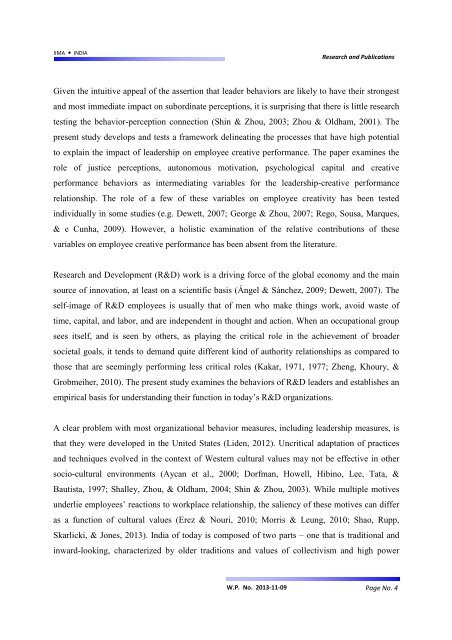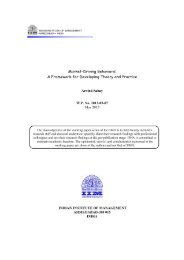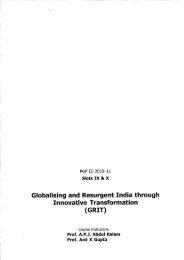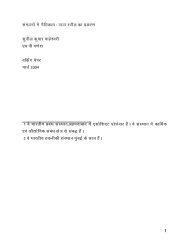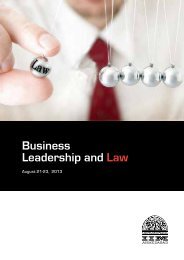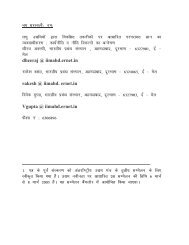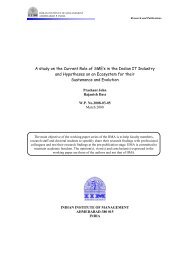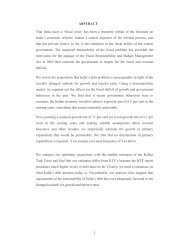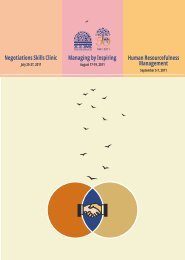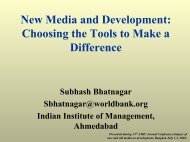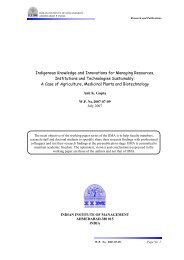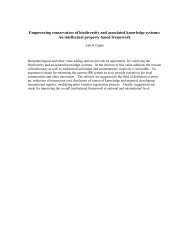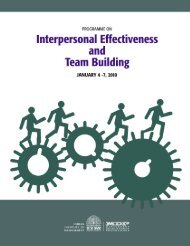to Download (English) File - Indian Institute of Management ...
to Download (English) File - Indian Institute of Management ...
to Download (English) File - Indian Institute of Management ...
You also want an ePaper? Increase the reach of your titles
YUMPU automatically turns print PDFs into web optimized ePapers that Google loves.
IIMA INDIA<br />
Research and Publications<br />
Given the intuitive appeal <strong>of</strong> the assertion that leader behaviors are likely <strong>to</strong> have their strongest<br />
and most immediate impact on subordinate perceptions, it is surprising that there is little research<br />
testing the behavior-perception connection (Shin & Zhou, 2003; Zhou & Oldham, 2001). The<br />
present study develops and tests a framework delineating the processes that have high potential<br />
<strong>to</strong> explain the impact <strong>of</strong> leadership on employee creative performance. The paper examines the<br />
role <strong>of</strong> justice perceptions, au<strong>to</strong>nomous motivation, psychological capital and creative<br />
performance behaviors as intermediating variables for the leadership-creative performance<br />
relationship. The role <strong>of</strong> a few <strong>of</strong> these variables on employee creativity has been tested<br />
individually in some studies (e.g. Dewett, 2007; George & Zhou, 2007; Rego, Sousa, Marques,<br />
& e Cunha, 2009). However, a holistic examination <strong>of</strong> the relative contributions <strong>of</strong> these<br />
variables on employee creative performance has been absent from the literature.<br />
Research and Development (R&D) work is a driving force <strong>of</strong> the global economy and the main<br />
source <strong>of</strong> innovation, at least on a scientific basis (Ángel & Sánchez, 2009; Dewett, 2007). The<br />
self-image <strong>of</strong> R&D employees is usually that <strong>of</strong> men who make things work, avoid waste <strong>of</strong><br />
time, capital, and labor, and are independent in thought and action. When an occupational group<br />
sees itself, and is seen by others, as playing the critical role in the achievement <strong>of</strong> broader<br />
societal goals, it tends <strong>to</strong> demand quite different kind <strong>of</strong> authority relationships as compared <strong>to</strong><br />
those that are seemingly performing less critical roles (Kakar, 1971, 1977; Zheng, Khoury, &<br />
Grobmeiher, 2010). The present study examines the behaviors <strong>of</strong> R&D leaders and establishes an<br />
empirical basis for understanding their function in <strong>to</strong>day’s R&D organizations.<br />
A clear problem with most organizational behavior measures, including leadership measures, is<br />
that they were developed in the United States (Liden, 2012). Uncritical adaptation <strong>of</strong> practices<br />
and techniques evolved in the context <strong>of</strong> Western cultural values may not be effective in other<br />
socio-cultural environments (Aycan et al., 2000; Dorfman, Howell, Hibino, Lee, Tata, &<br />
Bautista, 1997; Shalley, Zhou, & Oldham, 2004; Shin & Zhou, 2003). While multiple motives<br />
underlie employees’ reactions <strong>to</strong> workplace relationship, the saliency <strong>of</strong> these motives can differ<br />
as a function <strong>of</strong> cultural values (Erez & Nouri, 2010; Morris & Leung, 2010; Shao, Rupp,<br />
Skarlicki, & Jones, 2013). India <strong>of</strong> <strong>to</strong>day is composed <strong>of</strong> two parts – one that is traditional and<br />
inward-looking, characterized by older traditions and values <strong>of</strong> collectivism and high power<br />
W.P. No. 2013-11-09<br />
Page No. 4


